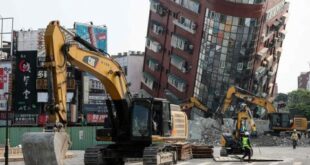Some fear the transition to EV batteries isn't without environmental consequences

Along with the massive recent manufacturing investments in electric vehicle (EV) technology and talks of a greener, decarbonized future, there are some not-so-green problems.
In its latest New Energy Finance report, Bloomberg News predicts there will be some 730 million EVs on the road by 2040. The year before, Bloomberg predicted half of all U.S. vehicle sales would be battery electric by 2030.
In Canada, too, there's talk of a big economic boost with the transition to EVs — including 250,000 jobs and $48 billion a year added to the nation's economy through the creation of a domestic supply chain.
- Country Checkup wants to know: What was the most important news story of 2023? Which story didn't get enough attention?Fill out the details on this form and send us your stories.
Governments have already invested tens of billions into two EV battery manufacturing plants in southwestern Ontario. However, they come with the environmental dilemma of what to do with the millions of EV batteries when they reach the end of their life.
Dead battery dilemma
"The rules are non-existent," said Mark Winfield, a professor at York University in Toronto and co-chair of the school's Sustainable Energy Initiative. "There is nothing as we talk to agencies on both sides of the border, the federal, provincial, state levels.
"In the case of Ontario, the answer was actually that we have no intention of doing anything about this."
When asked for its response, the Ontario Ministry of the Environment, Conservation and Parks did not return a request for comment from CBC News.
Winfield said the fact there is no public policy on the disposal of EV batteries is concerning because a number of the chemicals and components used to make EV batteries, such as cadmium, arsenic and nickel are listed as toxic under the Canadian Environmental Protection Act (CEPA) and simply can't be thrown into a landfill.

Battery packs for electric vehicle are set to be produced in the millions in our region with new plants coming to Southwestern Ontario. But what happens when those batteries die and there is waste to deal with? Mark Winfield is a professor at York University who is sounding the alarm on the fact there is currently no clear plan. He joins host Colin Butler with more.
"You would think given the nature of these products and also the scale of the potential looming problem, as you know, when the EV sales move into the tens of millions and every one of those ultimately is going to result in an end-of-life battery. One would have expected regulators to be a little bit further ahead of the curve."
Critical minerals come with costs
The environmental costs of a greener future in transportation don't stop at dead batteries. If the country carries through on its plan to build a home-grown supply chain for the critical minerals needed to make EV batteries, it could mean the development of a vast tract of unspoiled nature in Ontario's north.

To get the critical minerals necessary to build EV batteries, Canada will have to develop the Ring of Fire, a deposit of minerals discovered in Ontario's far north in 2007 — one that happens to be in the middle of an environmentally significant area called the Hudson's Bay Lowlands.
"We're talking about a huge wetland," said Dayna Scott, a professor with the Osgoode Law School at York University and the school's research chair in environmental law and justice in the green economy.
"The largest intact boreal forest remaining in the world and also a massive carbon storehouse."
A lot of people who are interested in buying an electric vehicle don't want to see themselves as caught up in an ongoing process of Indigenous dispossession.
– Dayna Scott
In the Hudson's Bay Lowlands, there are an estimated 35 billion tonnes of carbon, acts as a major stopover for billions of migratory birds and is home to wolverines, caribou and lake sturgeon — all considered endangered, or species at risk by the federal government.
For years, Scott has studied the social, environmental and legal implications of bringing development to the Hudson's Bay Lowlands and its effect on the rights and interests of remote Indigenous communities there.
"They hold the inherent jurisdiction to be the decision-makers for those lands. They also hold a right of free, prior and informed consent, which comes from international law. That means [governments] need to get the consent of all of the communities that are going to be impacted by this major irreversible change to their way of life."
The Indigenous communities fall under the James Bay Treaty, or Treaty 9 and while some favour development, others are opposed.
To curry their favour, those for and against development are both using climate and the environment to justify their cause, Scott said.

With tens of billions being invested in electric vehicle plants in both Windsor and St. Thomas, little attention is being paid to the environmental costs of decarbonizing the transportation sector. Dayna Scott is a law professor who has been studying the overlapping jurisdictions and claims of climate justice in Treaty 9 territory, where the "ring of fire" and Hudson's Bay Lowlands lie. Scott joins host Colin Butler to discuss.
She said those who want to mine critical minerals in the area argue that would lead to a reduction in emissions and save the planet, while those who want to leave the area untouched argue destroying one of the world's largest carbon sinks by developing it would only undo all those emission reductions from EV batteries.
While it's impossible to tell who's right, Scott said governments need buy-in from every First Nation in the Treaty 9 area or any development would be open to litigation — some rarely mentioned at news conferences or funding announcements about the upcoming switch to Canadian-made EV batteries.
"A lot of people who are interested in buying an electric vehicle don't want to see themselves as caught up in an ongoing process of Indigenous dispossession," Scott said. "If people did have to confront at what cost we are going to get these minerals, do we want to do it over Indigenous People's objections?
"I think that would give a lot of people in southern Ontario pause, probably."
*****
Credit belongs to : www.cbc.ca
 MaharlikaNews | Canada Leading Online Filipino Newspaper Portal The No. 1 most engaged information website for Filipino – Canadian in Canada. MaharlikaNews.com received almost a quarter a million visitors in 2020.
MaharlikaNews | Canada Leading Online Filipino Newspaper Portal The No. 1 most engaged information website for Filipino – Canadian in Canada. MaharlikaNews.com received almost a quarter a million visitors in 2020.







